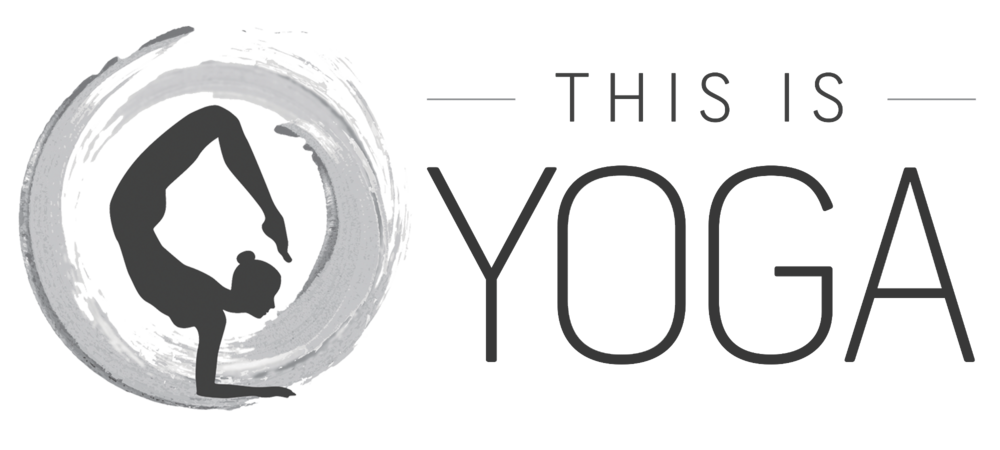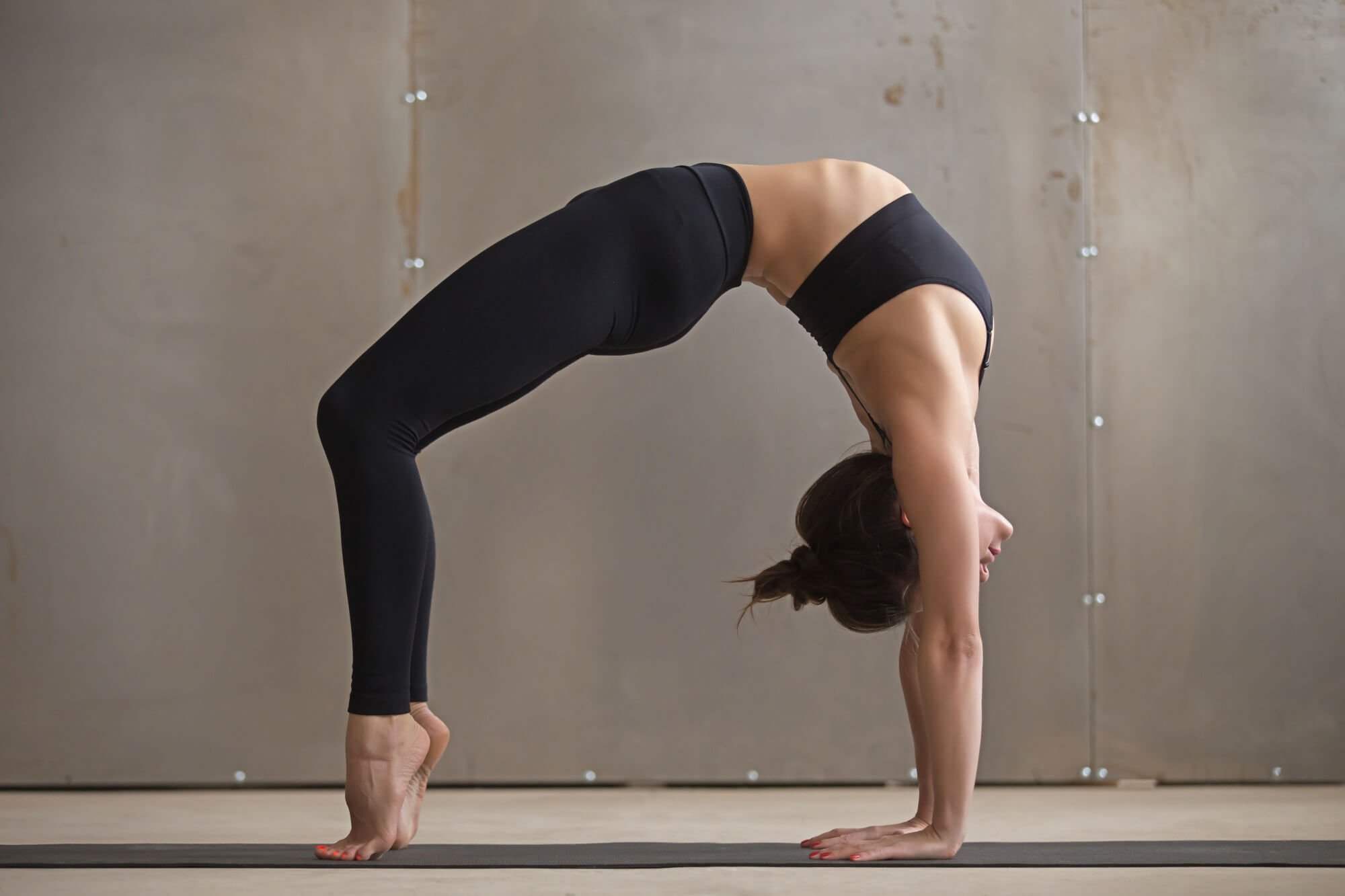We often think of muscles like a rubber band; pull them harder and they will stretch longer. The problem is that most of our muscles are old, rigid rubber bands that will snap the minute you pull them too far. Another problem is that our muscles don’t work exactly like rubber bands. So how do our muscles function and how do they stretch longer? Enter flexibility: range of body motion that loosens us up.
What flexibility is… and what it is not
Before we can pull our muscles every which way in our yoga poses, we have to loosen them up.
Believe it or not, our flexibility is not determined by our muscles; the nervous system determines our flexibility. Take tight hamstrings as an example. Say you have tight hamstrings and you do a deep forward fold. Your brain will send the flashing red “danger” signal to your hamstrings (via your nervous system) and your hamstrings will respond by contracting. They do this as a survival mechanism; when they contract they may lose flexibility, but they gain strength, which they use to protect you.
Your first instinct might be to push past this feeling into a deeper stretch. But pulling yourself deeper won’t improve your flexibility and could actually cause you to get injured. Yoga for flexibility is not about pulling on our muscles until they grow longer, it’s about teaching our muscles to relax when we hit our limits. A relaxed muscle is a loose muscle, and that is where you find flexibility.
Why flexibility is important
Regularly practicing Yoga poses for flexibility have many health benefits. Stretching is a great way to increase your mobility, improve your range of motion and reduce the risk of injury. Flexible exercises are an important part of any workout routine. They help you avoid injury and keep your body limber. You should also stretch before and after workouts to prevent soreness and muscle fatigue. Stretching helps increase blood flow, improves circulation, and increases joint mobility. Flexibility is essential for maintaining a healthy spine and avoiding back problems.
Stretching helps us release tension and stress. It improves overall physical health and mental health. Yoga poses are great for correcting poor posture, improving sleep quality, cultivating body awareness and boosting mood.
How to improve your flexibility
I constantly remind my students that flexibility does not come from pushing past your limits, but from reaching your edge and staying there. The number one way to improve your flexibility is to keep practicing. Keep these flexibility tips in mind during your next yoga practice.
Play with your limits—While you do not want to force yourself beyond your limit, you also do not want to stay too far on the other side. The only way to learn (and expand) your body’s limits is to play along the edge.
Use your breath—With every inhale, focus on alignment and check on the integrity of your posture. With every exhale, think about letting go and sinking a little deeper into the posture.
Remain calm—A lot of our muscle tension comes from a fearful brain. This turns on the sympathetic nervous system, which triggers muscle contraction. Keep your breath long and smooth and remind yourself that you are safe so your brain and nervous system can relax. This will inevitably lead to your muscles relaxing.
Stay awhile—Maybe yin yoga is not your thing, but there is quite a bit of science that supports the argument that your muscles need time to relax. Staying in a pose for five breaths is good for your muscles, but stay for five minutes and you might be amazed by how much deeper your muscles relaxed at the end compared to when you started.
Whether your regular practice consists of intense vinyasa classes or relaxing yin classes, if you follow these tips you will see shifts in your flexibility. Just remember—stop worrying about lengthening and focus on relaxing!
How does yoga help improve flexibility?
Yoga isn’t just about stretching. Yoga is an ancient practice that combines physical movement, breathing techniques, meditation, and philosophy. Yoga differs from just stretching because it focuses on safety, form, and the variety of poses that target both major muscle groups and deeper-seated stealth muscles. Yoga emphasizes proper alignment, attention, and the awareness of your body.
It helps us to understand our bodies and minds better. It teaches us to focus on our breath and body while we move. It teaches us to calm down and relax. And it teaches us to become aware of what we’re doing and why.
12 yoga postures for flexibility
Most asanas have a balance of both strength and flexibility, but there are a handful of positions that will be most helpful to increase your flexibility. These poses require minimal effort so you can focus on relaxing, breathing and relaxing into the stretch. Start with just a few of these poses each week until you feel comfortable enough to add more.
Bound Angle pose
Baddha Konasana is a great pose for beginners because you get to stretch your hips while opening your chest. Holding this asana for several deep breaths will stretch the adductors, inner quadriceps, and hamstrings. Feel your heart expand as. you let your shoulders drop down and your spine lengthen. This pose helps you release any tension and stress in your body and stimulates the reproductive, nervous and respiratory systems. It also helps you prepare for meditation and other seated yoga postures.
Wide Legged Seated Angle pose
This hip opening pose is perfect for those who struggle with tight hamstrings. Upavistha Konasana opens up and stretches out your inner thighs while stretching the entire back side of the body: legs, back, and arms. It also helps Strengthens the calves, ankle, hamstrings, glutes, abdomen, and spine. If you find this pose difficult, try placing a folded blanket under your hip bones or use a bolster under your chest.
Triangle pose
Utthita Trikonasana is a great pose for stretching out your muscles in your legs and in the sides of your body. Triangle pose can increase stability by activating your core muscles. Keeping the lower hand lightly touching the floor engages your core strength which helps you gain confidence and feel stronger. Triangle pose stimulates your organs, including your digestive system, which can improve your metabolism. It reduces stress by targeting the lower back, which can cause tension and pain. It can also help relieve stress, anxiety and help stabilize emotions.
Child’s Pose
Balasana is a great pose to relax the entire body, and it’s a great resting pose after practicing a challenging asana. Child’s pose is a simple yet effective position that gently stretches the low back muscles. Breathing deeply in this pose also massages and tones the abdominal organs to help them function properly. It also helps reduce stress by calming the mind and soothing the nervous system.
Supine Pigeon pose
Supta Kapotasana is a great pose for beginner students or for people with tight hips. Reclined pigeon pose provides an opportunity for us to gently stretch the hips, thighs, and low back. It helps prepare us for backbends, as well as for sitting meditation. It allows us to open the front side of the pelvis, which is often tight and contracted when we sit still for extended periods of time. Reclined pigeon pose provides us with a great opportunity to practice patience and surrender.
Standing Forward Bend
Uttanasana is a great pose to lengthen your hamstrings. Standing Forward Fold stretches the hamstrings, hip flexors, and calves. It stretches the backside of the body, which improves posture and spinal alignment. It calms the mind and relieves stress. It also stimulates the liver and kidneys and helps improve digestion.
If you’re feeling your legs or low back extra tight, bend your knees slightly. To relax deeper into the stretch, grab opposite elbows and let yourself hang upside down.
Seated Head to Knee pose
Janu Sirsasana improves flexibility in your back, hip, and thigh muscles. It also increases blood circulation in the lower abdomen and relieves stress. Seated Head to Knee is a great pose to stretch the hamstrings, the muscles of the inner thigh and groin. It helps to calm the nervous system, eliminate mild depression, and improve digestion. Janu Shirshasana helps us release tension in the hips, knees, and lower back. It’s a great pose to practice when you feel stressed out, anxious, or depressed. Use a yoga strap around the foot of the straight leg if you cannot reach your toes.
Half Lord of the Fishes pose
Ardha Matsyendrasana elongates and aligns the spine and strengthens the core muscles. This seated twist provides a great stretch for the back muscles along the spine. It improves posture and provides relief from lower back pain. It can help with digestion, constipation, and indigestion. This asanas’ twisting action is said to stimulate heart, kidneys, liver, spleen and lungs.
Cat-Cow pose
Bitilasana and Marjaryasana is an easy movement for beginners to warm up the spine and stretch the hip flexors, abdominals and back muscles. It creates coordination, improves focus, and invigorates prana by activating the diaphragm and breathing deeply into the belly. It improves digestion, relieves stress, and calms the brain. Flowing with the breath between arching and rounding the spine creates emotional balance by helping us release pent-up emotions and feelings.
Pyramid pose
Parsvottanasana is a great pose for stretching the hamstrings, calves, quads, hips, glutes and back muscles. It strengthening the legs, hips, ankles and the feet to maintain the stability of the body. Parsvottanasana improves blood circulation in the head, which calms the nervous system and improves brain function. Deep conscious breathing in this asana further encourages the release of tension in the lower back, legs and hips, as well as in the shoulders and upper back. This asana opens the throat chakra, which is associated with communication and expression. It also activates the sacral chakra, which is related to creativity, sexuality, and self-expression.
Cobra pose
Bhujangasana stretches the entire front side of the body, including the hips, abdominals, chest and the tops of the feet. Cobra Pose has been shown to improve sleep quality, reduce stress, and increase energy. It’s a great posture to practice before bedtime, as well as during the day if you need some extra energy. It can help reduce back pain and inflammation. It also builds muscle strength in the arms, core, and upper body. In addition, there’s evidence that practicing Cobra Pose regularly improves posture, self-esteem, and symptoms of depression.
One Legged King Pigeon pose
Eka pada rajakapotasana is a deep hip opener that improves flexibility in hips, legs, pelvis and groin. It stretches the thighs, psoas, glutes, hip flexors, and piriformis muscles. This asana helps to release tension in your hips, lower back, shoulders, and chest. If your hips are tight, you can place blocks or blankets under your hip bones for support.
Breathing deeply in Pigeon Pose improves nervous imbalances and stimulates the internal abdominal organs. According to Ayurveda, stress, sadness, and worry are stored in the hips, so this asana encourages an emotional release and regulation. Regular practice of this pose may help relieve anxiety or stress.






